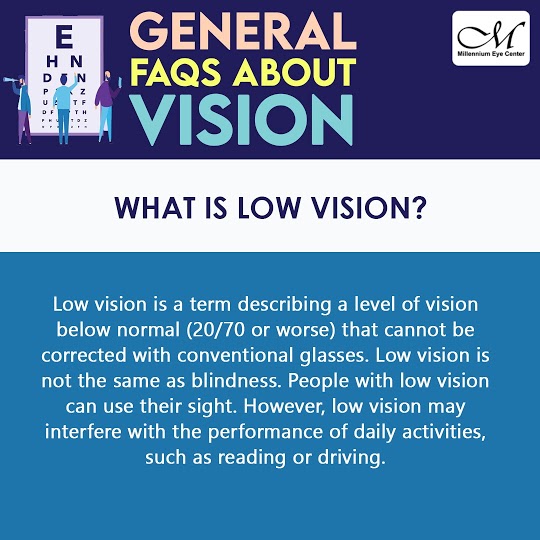What is Low Vision?
Low vision means having visual acuity below normal (20/20 vision or worse) that cannot be corrected by glasses, surgery or medication. Also, a person with lower than 20 degrees of peripheral vision may be treated for low vision. The most common cause of low vision is macular degeneration, an age-related disease that affects the central portion of the visual field. Other common causes include glaucoma, cataracts, diabetes, RP, and other eye diseases.
Low vision often interferes with the performance of daily living activities such as reading, remaining, and driving.
Low-vision therapy typically includes an evaluation of the patient’s visual abilities, prescription of low-vision devices, and training in their use. The goal is to maximize the use of the patient’s available vision for reading, writing, hobbies, and work-related tasks such as working at a computer.
How is Low Vision Treated?
A Low Vision Evaluation can help someone understand how to use their remaining vision more effectively, and to use adaptive methods to increase independence and reach their goals.
Dr. Lauretta Justin is a low-vision specialist. She is trained to work with people who have visual impairments to help them become as independent as possible. Like other types of occupational therapists, her goal is to empower her patients so that they can live independently.
Here are the Low Vision treatment options offered at Millennium Eye Center.
- Electronic technology. Many high-tech vision aids are available. They include video reading systems that enlarge type 60 times, auto-focus spectacle telescopes, and talking computer systems.
- Special eyeglasses. Stronger-than-typical bifocal or trifocal glasses help you see better. We also offer high-power, prismatic “half-eye” reading glasses. These help the good spots in one eye cancel out the bad spots in another.
- Magnifiers. Magnification devices can be hand-held, free-standing, or mounted to eyeglasses. You can also wear magnifiers around your neck. Many models have a built-in light or incorporate various levels of magnification.
- Telescopes. A variety of miniature telescopes and binoculars, some worn like eyeglasses, may help you with distance viewing.
With low vision therapy, low vision aids, and adaptive technology, people with low vision can maximize their remaining sight and live independently. Click HERE to view the available low-vision aids to help improve functional vision.
How to get started with Low Vision Therapy
To learn more about low-vision solutions, schedule your appointment by clicking HERE or call/text us at 407-292-9812.

